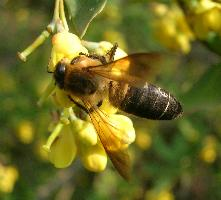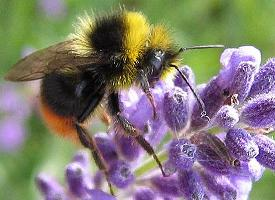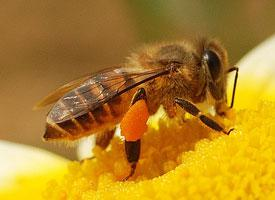
Description de l'animal
The Western honey bee, scientifically known as Apis mellifera, is a highly social and economically significant insect that plays a crucial role in the pollination of various crops and wild plants around the globe. Originating from Europe, Africa, and parts of Asia, this species has been introduced to every continent except Antarctica, demonstrating its adaptability and the broad extent of its ecological impact.Apis mellifera is distinguishable by its segmented body, which is divided into three main parts: the head, thorax, and abdomen. The head houses complex eyes that are sensitive to ultraviolet light, antennae that serve as sensory organs, and mandibles used for manipulating wax and other materials. The thorax is the muscle center, equipped with two pairs of wings and three pairs of legs, each with specialized functions such as pollen collection, grooming, or defense. The abdomen contains vital internal organs, including the sting used for defense, and in the case of the queen, reproductive organs.
One of the most remarkable aspects of the Western honey bee is its sophisticated social structure. Colonies can consist of tens of thousands of individuals, categorized into three primary castes: the queen, workers, and drones. The queen is the only fertile female in the colony, responsible for laying all the eggs from which the colony's members are born. Worker bees are infertile females that perform the majority of the labor within the colony, including foraging for nectar and pollen, caring for the brood, defending the hive, and maintaining the internal environment. Drones are the male bees, whose sole purpose is to mate with a virgin queen, after which they typically die.
Communication within the colony is highly developed in Apis mellifera. Bees use a combination of chemical signals, or pheromones, and sophisticated dances to convey information about the location, quality, and quantity of food sources to their nestmates. The "waggle dance," for example, is a well-studied behavior where a foraging bee communicates the direction and distance of a food source from the hive.
Western honey bees are renowned for their ability to produce honey from the nectar of flowers. This process involves the collection of nectar, its conversion into honey through the gradual reduction of water content, and its storage in wax cells within the hive. Honey serves as a vital food reserve for the colony, especially during colder months when foraging is limited.
The role of Apis mellifera in pollination is indispensable to both natural ecosystems and human agriculture. As bees forage for nectar and pollen, they inadvertently transfer pollen from the male structures to the female structures of flowers, facilitating the reproductive process of plants. This service is critical for the production of many fruits, vegetables, and nuts, making the Western honey bee an essential player in global food security.
Despite their importance, Western honey bees face numerous threats, including habitat loss, pesticides, diseases, and parasites like the Varroa mite. Colony Collapse Disorder (CCD), a phenomenon where worker bees mysteriously disappear, leaving behind a queen and a few attendants, has also contributed to declines in bee populations. These challenges have mobilized global efforts in bee conservation, highlighting the necessity of sustainable practices to ensure the survival of this vital species.
In summary, the Western honey bee, Apis mellifera, is a remarkable creature with complex social structures, sophisticated communication methods, and an indispensable role in the natural world and human economy. Its ability to adapt to various climates and ecosystems has made it a subject of fascination and study, underscoring the importance of its conservation for future generations.
Animaux similaires
Nouvelles photos d'animaux
Top 10 des animaux
- Dolphin gull (Leucophaeus scoresbii)
- Diana monkey (Cercopithecus diana)
- Moustached guenon (Cercopithecus cephus)
- Galápagos tortoise (Geochelone nigra complex)
- Japanese macaque (Macaca fuscata)
- Russian tortoise (Testudo horsfieldii)
- Stone loach (Barbatula barbatula)
- Greek tortoise (Testudo graeca)
- Common flying dragon (Draco volans)
- Vendace (Coregonus albula)


